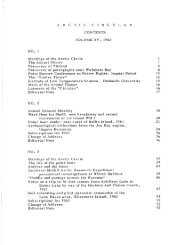VCL. VIII NC. I THE ,,-RCTIe CIRCULt>.R 12.effect of this climatic change on the waters of the former walrusrange is difficult to estimate except for the last hundred years. andespecially the last thirty years, and it will be assumed for thepresent that the restriction in the walrus range cannot be ascribedto such change in climate, at least not to any significant degree inCanada.<strong>The</strong>re is little doubt that the depredations of commercialhunting have been decisive in the process, from the late middle agesdown to the end of the nineteenth century. In the early days ofthe trade. walrus hides. obtained mainly in northern Europe, werein great demand for use in the making of ships' rigging, quite apartfrom the value of the ivory. Walrus were still killed for conunercialpurposes in this present century, up to 19L~3 at least. particularlyby Norwegian shiJ?s. and notably in Davis Strait. It is understoodthat this practice has stoi'ped, by agreement. In Canada, walrusmay be killed only by native Eskimo. and even in native hunts thereis officially supposed to be a government agent. usually a member,of the Royal Canadian Mounted J-·olice, present to supervise thehunt. It is not possible, however, to obey this regulation to theletter in practice.In spite of the cessation of conunercial killing of walrusby white men, there is no sign of recovery in the walrus Fopulation.<strong>The</strong>re is indeed at least one good a priori ground for suspectingthat the numbers are still dedining;-;~elythe deterioration ofthe native hunting metho:is in certain parts of the north. I believethere is a regulation of-erating in the Thule district, to the effectthat a walrus must be harpooned before the rifle is used. Thismost excellent rule, if introduced into Canada, might go far toremedy the present situation. But unfortunatdy the rifle hasbeen used for so long as the first weaFon of hunting that it is verydoubtful whether the regulation could be enforced. Meantime, theintroduction of the rifle has. amongst other things. had the effectof making some ";'skimo "trigger -bar-lOY". ,,-.pecially since governmentrdief to families, and family allowanc-es, have maoe cartridgethriftless important. <strong>The</strong> result is that hunting partias in UngavaBay, for instance, formerly models of stelth and cunning, nowrival those fairy-tale hunters in "Feter and the Wolf". "comingthrough the forest, and shooting as they corne", <strong>The</strong> total fire-Fower of the hunting lcarty i" let loos e on the herd of walrus,wounding rath"r than killing, and allowing many maimed animalsto escar-e, to di" later. Fregnant females are killed and woundedas well as males, so that the total waste is difficult to estimate.
VOL. vm NC. r TH£ .·.BoCTIC CIRCUkR 13Quite apart from the waste involved in the escape of mortally woundedanimals. there is also the danger. in summer. of animals sinkingbefore they can be harpooned. particularly in this haphazard methodof hunting. <strong>The</strong> loss involved in this way in walrus is not known. butestimates for seal are of the order of three animals lost for everyOne landed, a situation which would never be tolerated in sporthunting or fishing farther south. (<strong>The</strong> loss of walrus in the BeringSea, by this method of hunting. is known to be quite large).Two things are being done to remedy this trouble: (1) methodsof so supervising the annual walrus kill as to avoid all waste arebeing worked out by the Department of Northern ~ffairs, and (2) basicresearch is being undertaken by the Wildlife Service and by theFisheries Research Board, with the continuation of the researchthe responsibility of the latter organization.In a memorandum to the Department of Northern ~ffairsMr. l.M. Gardner. whose 1954 address was Sugluk. on Hudson Strait.has suggested that a number of boats. of the Feterhead type commonlyused in the Canadian north. should be employed exclusively in walrushunting. each boat supplying a small group of settlements or tradingposts. <strong>The</strong> crew would be Eskimo. but there would be an officer onboard responsible for the regulation of the hunting. Something ofthis sort has been considered for some time. and will f-robably provethe answer to the immediate problem of eliminating wasteful hunting.Only males would be killed. and each animal hunted individually.In point of fac·. the problem of walrus conservation isonly one part of the whole problem of the rehabilitation of the Eskimoeconomy in Canada. a matter which invel ve" the exploration of otherpossible resources at fresent unused or under_exploited. such asshark fishing, cod fishing in Ungava Bay. the full use of the widelydietributed arctic char. and the development of sheep farming incertain parts. <strong>The</strong> development of other activities of this sort willnot only relieve the pressure on the walrus but also allOW thebeginnings of a "corporate" organization of settlements, with agreater division of economic employment between the members ofeachseU1e ment than is the case at present.This, however. is not the whole solution. Before the walrustake can be rationally controlled it is necessary to know a great dealmore about the biology of the walrus than we know now. Res earchdesigned to meet this need is in progress, comprising the study ofthe reproductive rate, age composition, distribution, migratoryhabits and f'resent numbers. This is not the place to describe thiswork in detail. One point, however. the migratory habits of thewalrus. might well be mentioned.
- Page 1 and 2: Vol. 8CIHCULJ-..R
- Page 3 and 4: CONTENTSVol. VIII, 1955NO.1Meetings
- Page 5 and 6: •THE. dRCTIC CIRCULARVOL. Vlll NC
- Page 7 and 8: veL. Vlll NC. I THE ,."ReTIe CIRCUk
- Page 9 and 10: VGL. VIll NC. I THI;; rl.RCTIC cm.C
- Page 11 and 12: VOL. Vlll NC. ITHE ,.RCTIC CIRCULn.
- Page 13 and 14: oQ\CROZIER's LANDING Pl.AC£(VlCTOR
- Page 15: veL. VIII NC. I THE ARCTIC ClRCULh.
- Page 19 and 20: VOL. VIII NO. I THE ARCTIC CIRCULaR
- Page 21 and 22: VOL. VIII NO. I THE ARCTIC CIRCULAR
- Page 23 and 24: •THE ARCTIC CIRCULARVOL. VIII NO.
- Page 25 and 26: VOL. VIII NO. Z THE ARCTIC CIRCULAR
- Page 27 and 28: VOL, VIII NO. 2 THE ARCTIC CIRCULAR
- Page 29 and 30: VOL. VIII NO.2 THE ARCTIC CIRCULAR
- Page 31 and 32: VOL. VIII NO.2 THE ARCTIC CIRCULAR
- Page 33 and 34: 23 4 56 7 89 10•'OSTE. CAN A D
- Page 35 and 36: VOL. VlU NO. Z THE ARCTIC CIRCULAR
- Page 37 and 38: VOL. VIII NO.2 THE ARCTIC CIRCULAR
- Page 39 and 40: VOL. Vlli NO. Z THE ARCTIC CIRCULAR
- Page 41 and 42: VOL. VIII NO. ZTHE ARCTIC CIRCULAR3
- Page 43 and 44: VOL. VlII NO.3THE ARCTIC CIRCULARA
- Page 45 and 46: VOL. YIll NO.3THE ARCTIC CIRCULAR4"
- Page 47 and 48: VOL. VIIlNO. 3THE ARCTIC CIRCULAR6-
- Page 49 and 50: VOL. Vlli NO.3THE ARCTIC CIRCULAR8G
- Page 51 and 52: VOL. VllI NO.3THE ARCTIC CIRCULAR10
- Page 53 and 54: VOL. YIU NO.3 THE ARCTiC CIRCDLAR 1
- Page 55 and 56: VOL. VIII NO.3THE ARCTIC CIRCULARCo
- Page 57 and 58: VOL. VlII NO.3THE ARCTIC CIRCULAR16
- Page 59 and 60: VOL. VIII NO.3 THE ARCTIC CIRCULAR
- Page 61 and 62: VOL. VIn NO.3 THE ARCTIC CIRCULAR 2
- Page 63 and 64: VOL. VIII NO.3 THE ARCTIC CIRCULAR
- Page 65 and 66: VOL. VIII NO.3THE ARCTIC CIRCULAR2.
- Page 67 and 68:
VOL. VIII NO.3THE ARCTIC CIRCULAR
- Page 69 and 70:
VOL. VIll NO.3THE ARCTIC CIRCULAR2.
- Page 71 and 72:
VOL. VIII NO.3 THE ARCTIC CIRCULAR
- Page 73 and 74:
THE ARCTIC CIRCULARtVOL. VllI NO.4
- Page 75 and 76:
VOL, VIII NO.4THE ARCTIC CIRCULAR72
- Page 77 and 78:
VOL. VIII NO.4THE ARCTIC CIRCULARFi
- Page 79 and 80:
VOL. vm NO, 4THE ARCTIC CIRCULAR76B
- Page 81 and 82:
VOL. VIII NO.4THE ARCTIC CIRCULAR78
- Page 83 and 84:
VOL. VIII NO.4THE ARCTIC CIRCULAR80
- Page 85 and 86:
VOL. VIII NO.4 THE ARCTIC CIRCULAR
- Page 87 and 88:
INDEX TO VOLUME VIII, 1955AActiviti
- Page 89 and 90:
--86 Ellesmere Ice Shelf exped" 5
- Page 91 and 92:
-.88 NNares, Capt. Sir George, Pa
- Page 93:
,-~-- 90 Walrus, Atlantic, in Can












